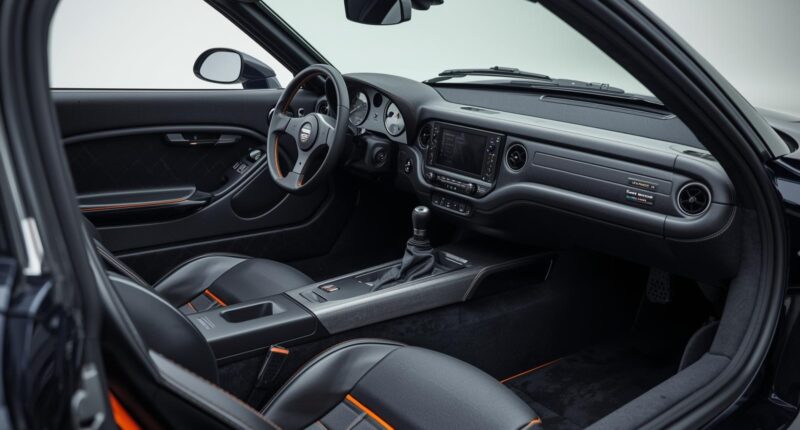In a world of hybrid hypercars, touchscreens, and computer-assisted driving, Gordon Murray Automotive’s T.50 stands apart as a love letter to the golden age of pure, mechanical driving. Designed by Professor Gordon Murray, the man behind the legendary McLaren F1, the T.50 is not just another supercar — it’s a spiritual successor to the F1 and a bold statement that driving should remain a human experience, not a digital one.
The Philosophy Behind the T.50
Gordon Murray’s Vision of Purity
Gordon Murray has always believed that the best driver’s car is one that puts the human being — not the computer — in control. The T.50 reflects this belief in every nut, bolt, and carbon fiber panel.
While most modern hypercars chase speed through hybrid assistance, active aero, and heavy electronics, the T.50 strips away the excess to deliver something lighter, sharper, and infinitely more involving. It’s a car that rewards skill over software, passion over programming.
Murray once said, “The T.50 is the purest, lightest, most driver-focused supercar ever built.” And every aspect of its design proves that claim.
Design – Simplicity as an Art Form
Form Follows Function
At first glance, the Gordon Murray T.50 may look understated compared to flamboyant hypercars like the Bugatti Chiron or Ferrari SF90. But that’s the point — every curve serves a purpose.
Its carbon-fiber monocoque and body panels keep weight to an astonishing 986 kg (just under one ton) — lighter than most small hatchbacks. Every gram saved contributes to agility and responsiveness, making the T.50 feel like an extension of the driver’s body.
The Iconic Rear Fan
The most striking feature of the T.50 is its 400mm rear-mounted fan, inspired by Murray’s 1978 Brabham BT46B “fan car.” This fan actively manages airflow under the car, creating enormous downforce when needed — and reducing drag at high speeds.
Unlike traditional wings and flaps, the fan-based system allows the T.50 to maintain aerodynamic balance without compromising design or visibility. It’s clever, beautiful engineering — just as you’d expect from Gordon Murray.
Engine – The Heart of a Legend
A Naturally Aspirated Masterpiece
At the core of the T.50 lies a 3.9-liter naturally aspirated V12, developed in collaboration with Cosworth. This engine revs to an astonishing 12,100 rpm, producing 654 horsepower and 344 lb-ft of torque — numbers that may seem modest compared to modern turbocharged monsters, but in a sub-ton car, they’re transformative.
The throttle response is instantaneous, the sound is symphonic, and the connection between the driver’s foot and the engine is mechanical perfection. Murray’s goal was simple: no turbo lag, no hybrid systems, no filters — just pure combustion and emotion.
Engine Weight and Design
Weighing just 178 kg, the Cosworth V12 is the lightest road car engine ever built. Its crankshaft is lighter than a laptop, and its responsiveness — from idle to redline in under 0.3 seconds — is unmatched by any production engine in the world.
This is not an engine that just powers the car — it defines it.
Transmission and Control – The Human Touch
Six-Speed Manual Perfection
In an era where paddle shifters dominate, the T.50 proudly features a six-speed manual gearbox built by Xtrac. The titanium gear lever connects directly to the transmission through a short, precise linkage that delivers a tactile, click-perfect shift every time.
Murray insisted that the shift feel must be mechanical art, and the result is arguably one of the finest manual transmissions ever built. Drivers describe it as an almost spiritual connection — one that modern dual-clutch systems can’t replicate.
Driver Over Electronics
There’s no traction control. No stability program. No power-assisted steering. Everything is unfiltered and analog, demanding skill and rewarding mastery.
It’s a car that doesn’t correct you — it communicates with you. The more you give, the more it gives back.
Interior – Focused Minimalism
Center-Seat Layout Returns
Just like the McLaren F1, the T.50 uses a central driving position. The driver sits in the middle, with two passenger seats slightly behind on either side. This configuration offers perfect visibility and balance, making every drive an immersive experience.
The cockpit is wrapped in carbon fiber, aluminum, and titanium — with zero touchscreens or unnecessary distractions. Physical switches control every essential function. The gauges are analog, clear, and driver-oriented.
This is not a car for showing off — it’s a car for driving.
Performance – Beyond the Numbers
Acceleration and Handling
While the T.50’s official 0–100 km/h (0–62 mph) time is around 2.8 seconds, the numbers hardly matter. What truly defines it is how it feels — agile, alive, and responsive in a way no modern supercar can match.
Thanks to its featherweight construction, it delivers instant steering feedback and balance that makes even racetrack maneuvers feel intuitive.
Aerodynamic Brilliance
The fan system provides multiple aerodynamic modes — including High Downforce, Streamline, and Braking Mode — adjusting grip and stability dynamically. Despite all this technology, it’s controlled manually, keeping the driver in command of the car’s character at all times.
Exclusivity and Craftsmanship
Hand-Built for Perfection
Only 100 units of the Gordon Murray T.50 will ever be built, each handcrafted at GMA’s facility in Surrey, England. Every customer goes through a bespoke process, tailoring details like materials, seating position, and instrument finishes.
Each car takes over 1,000 hours to assemble, ensuring flawless attention to detail. This isn’t mass production — it’s automotive artistry.
Price and Value
With a price tag of around £2.8 million (approximately $3.5 million), the T.50 is reserved for the most passionate collectors and purists. Yet, many enthusiasts consider it priceless — because it represents something that may never exist again: a completely analog supercar built in a digital age.
Legacy – The End of an Era
A Supercar That Looks Back to Move Forward
The Gordon Murray T.50 isn’t about setting records or chasing lap times. It’s about preserving the soul of driving. In Murray’s words, “It’s the car I always wanted to build — light, fast, and connected to the driver in every sense.”
As the world shifts toward electric and autonomous vehicles, the T.50 stands as a final salute to the purity of engineering — a reminder of what cars once were and what they could still be.
Final Thoughts – The Last Great Analogue Supercar
The T.50 is not just a car; it’s a statement. A declaration that driving can still be emotional, mechanical, and deeply personal.
Where others rely on screens and systems, Gordon Murray relies on craftsmanship, intelligence, and heart. In an industry moving toward automation, the T.50 is a tribute to human touch — the last great analogue supercar.









